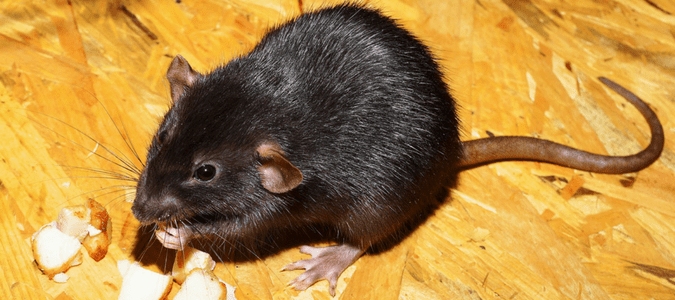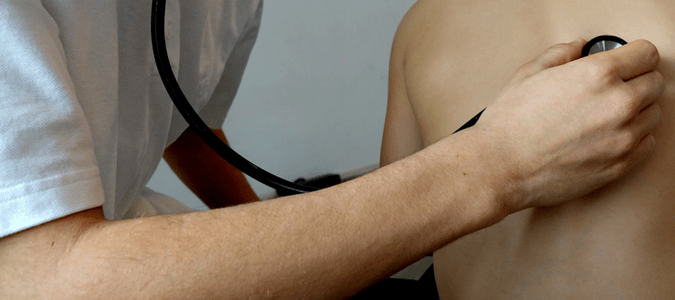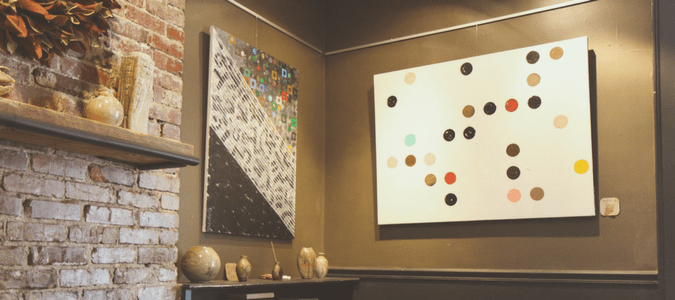
There are few pests which homeowners dislike as much as rats.
It’s easy to see why these furry creatures evoke such negative feelings. In addition to carrying diseases, rats can destroy your property by chewing and gnawing on wires, pipes, water hoses, wood doors, floors, walls, clothing, furniture, cement and more. These rodents can consume and contaminate your food, go through your trash and make a huge mess. Rats can also destroy crops.
To take care of a rat problem, you have to know which species of rat you are dealing with. There are over 50 species of rats, but only a few we are likely to see in and around our homes.
The roof rat (which has an almost comical scientific name: Rattus rattus) likes to be up high like its name suggests and usually nests in walls and attics. In the wild, these animals can be found in trees, among vines on fences and in parks and industrial areas. Many folks just refer to this species a black rat. The roof rat has a longer tail, more slender body, larger ears, larger eyes and a more pointed nose than a Norway rat. A roof rat weighs between five and eight ounces and measures 12-18 inches long, including its tail. As you might expect, black rats are grayish-black with a yellow belly. This species produces five to eight baby rats per litter and live one to two years.
Similar to squirrels, roof rats use their tails—which, unlike the Norway rat, grow to be longer than their bodies—to balance as they walk across electrical wires. This species is expert at climbing and are generally more agile than Norway rats. Roof rats have evolved to prefer to eat wheat, corn, seeds, vegetables and fruit.
The Norway rat is the more common of the two rodent species. Unlike the roof rat, the Norway rat (the species with the scientific name Rattus norvegicus) prefers to be underground, but can be found in a variety of places, including under buildings, in dumps and on farms. This type of rat is also called many other names, including a brown rat, sewer rat, common rat, street rat or wharf rat. Norway rats tend to look more well-fed and rounder than roof rats, with small eyes, close-set ears and a shorter tail. Because Norway rats tend to be larger, their droppings are also larger—about 3/4 inch long, whereas roof rat droppings are usually about half an inch.
While roof rats excel scaling your roof, Norway rats are powerful swimmers. These furry creatures can make their way into your plumbing by squeezing their way into your toilet’s water seal and coming out in your toilet bowl. Norway rats prefer to move over flat surfaces, although they can climb if needed. This species will often enter your property at the foundation or even below ground. Although both species of rat will eat whatever is available, the Norway rat likes to eat more protein and carbohydrate-rich foods including meat, sugar, beans, bread and in rare cases, even injured rats.
If you don’t see the rat itself, another way you can tell one of these species is nearby is if you notice droppings, tracks, burrows, gnaw marks, sounds, and smudge marks left by their oil and dirt.

Norway Rat Diseases
Rats can carry a variety of diseases which can affect people. Different species of rats carry different diseases.
The Norway rat, in particular, can carry hemorrhagic fever with renal syndrome, leptospirosis, Lyme disease, the plague, rat-bite fever, salmonellosis and tularemia, which can lead to severe health concerns.
Hemorrhagic Fever With Renal Syndrome
This disease is carried by Norway rats, as well as by the striped field mouse, the bank vole and the yellow field mouse, according to the Center for Disease Control. This illness is primarily found in eastern Asia, Russia, Korea, Scandinavian western Europe and the Balkans, so we don’t really have too much to worry about hemorrhagic fever here in the United States. The disease spreads through contaminated dust that is breathed in, direct contact with an infected rat or their urine or droppings, bite wounds from these rodents and from direct contact with an infected person.
In the Americas, the hantavirus causes hantavirus pulmonary syndrome, which is a severe and sometimes fatal respiratory disease. No cases of hantavirus have been reported in the United States.
Leptospirosis
This bacterial disease affects people and animals and can cause high fever, headache, chills, muscle aches, vomiting, jaundice, red eyes, abdominal pain, diarrhea and rashes. Some infected people have no symptoms, but if left untreated, leptospirosis can cause kidney damage, meningitis, liver failure, respiratory distress and death.
This disease is carried by rodents and other animals and can be found all over the world. Leptospirosis can be spread by eating or drinking contaminated food or water where an infected animal or rodent has urinated. Transmission can also occur through the skin or mucous membranes when someone comes into contact with similarly contaminated water or soil.
Lyme Disease
Rats act as hosts of this dangerous disease. When a flea or tick ingests the blood of an infected rat, these pests can then infect other animals and humans. Lyme disease is a serious bacterial infection which can spread to your joints, heart and nervous system if left untreated. Symptoms include fever, headache, fatigue and skin rashes.
Plague
Believe it or not, the plague is still around. Although the disease is rare, cases are diagnosed each year in the western United States, from west Texas to California. People are infected when they are bitten by a rodent flea that carries the plague bacterium or by handling an animal infected with the plague. Even though the plague killed millions in the past, modern medicine can treat those who are infected. Without proper medical treatment, the plague can still cause illness and death.
The documented cases here in the US have been the bubonic strain of the plague; symptoms of the illness include fever, headache, chills, weakness and swollen lymph nodes.
Rat-Bite Fever
Carried by both rats and mice, the bacteria that causes rat-bite fever has been found in North America. The fever is usually spread through a bite or scratch by an infected rodent. You may also contract the illness if you come into contact with a dead infected rodent. In some cases, rat bite fever has been spread through contaminated food or drinking water.
If you experience fever, vomiting, headache, muscle pain, joint pain or rashes within three to 10 days of coming into contact with a rat or dead rodent, you should seek medical attention. You may have come into contact with Streptobacillary RBF, which is another serious and sometimes fatal disease.
Salmonellosis
As is the case with other illnesses transmitted by Norway rats, this bacterial disease is caused by eating or drinking contaminated food or water. Most people refer to this condition as salmonella poisoning or a salmonella infection. This disease, which is carried by rats and mice, affects over one million people each year. Pet rodents and reptiles have also been known to transmit the disease to their owners. This foodborne illness can cause diarrhea, fever or abdominal cramps in some, although other infected individuals experience no symptoms. According to the Mayo Clinic, most people recover within a few days on their own.
Tularemia
Tularemia can infect animals and humans and is spread through a bite by a tick or deer fly, contact with infected animals or rodents, drinking contaminated water, inhaling contaminated aerosols or agricultural dust.
Symptoms include skin ulcers, swollen lymph glands, eye irritation or inflammation, sore throat, mouth ulcer, tonsillitis, cough, chest pain and difficulty breathing, depending on how the bacteria entered your body.
The bottom line? Having Norway rats in and around your home, in close proximity to your family, is a real health risk.
Norway Rat Facts
Preferring to stay low, Norway rats like to burrow under foundations and in basements, in floors, sewers and subways to rifle through your trash, in search of their next meal. According to the Internet Center for Wildlife Damage Management (ICWDM), the Norway rat was first introduced into the United States in 1775 via European ships.
Norway rats weigh between seven and 18 ounces and are typically 11 to 19 inches long, including their tails. These rodents have brown or reddish gray fur with a whitish gray belly and furless tail. Brown rats produce six to 12 babies per litter and live one to two years. Female rats carry their young from 21 to 23 days and wean them when they are three to four weeks old.
WRAL, a news station in North Carolina, shared the following facts about Norway rats:
- Norway rats don’t have collapsible skeletons, despite being able to squeeze through small spaces.
- These rodents are not actually from Norway.
- These pests can chew through plastic garbage cans, but not metal, as this material is more resistant.
- Norway rats like human food, including bulk grains and meat, as well as pet food.
- These pervasive pests can even burrow through cement.
Scratching Noise in Wall Cavity
Rats are not as quiet as a mouse. Sometimes you can hear them gnawing, climbing, clawing, squeaking or fighting, usually at night when these rodents are most active. Rats are prolific, so they are regularly searching for safe places to nest, which could be inside of your walls. Female rats are in heat every four to five days and can mate even within a day or two after giving birth. The ICWDM estimates an average female rat will give birth four to six times per year, producing 20 or more baby rats annually. Norway rats live in colonies, similiar to roof rats. Norway rat colonies tend to have 40 or fewer members, which is still enough to hear if they are on the move and you are closeby.
If rodents are inside your walls, chances are they are also in your home and will consume and possibly contaminate your food, pet food, clothes, books, electrical wiring and more. The damage these pests can cause in your home and to your possessions can be significant.

What Attracts Rats Outside
Rats often travel 100 to 150 feet from their nest to forage for food and water. These animals are attracted to poor sanitation, food that is left out (including pet food), garbage left in the open or easily-accessible trash cans or dumpsters.
Sewers attract Norway rats, hence the nickname sewer rat. These pests are great swimmers and use these passageways to travel and live.
Rats come onto your property in search of food and water, and they often find that inside your home.
To help make your home undesirable to rats, there are a number of things you can do to keep rats away, including:
- Making sure your outdoor trash cans are tightly sealed so they aren’t accessible by rats or mice.
- Removing debris and controlling weeds and grass around your home so rodents have fewer potential hiding spots.
- Avoiding having stacks of firewood, lumber or other items by your home or outside which are another common place rodents nest.
- Storing food in containers which are impossible for them to get into. On a related note, don’t leave food sitting out that can attract rodents.
- Keeping pet food in secure containers and not leaving uneaten food out all day indoors. Feeding your animals outside can also attract these pests.
- Washing your dishes after each meal or at least nightly.
- Picking up any ripe fruit or vegetables, especially any that have fallen on the ground if you have a garden.
- Disposing of old appliances promptly so they don’t remain on your property.
- Decluttering your living space.
- Covering any openings into your home with mesh, including vents and sealing any holes.
ABC Can Identify And Handle Any Rodent Problem
Most of us don’t have the knowledge to distinguish between different rodent species and have a hard time getting rid of rodents on their own. When it comes to rodents, pests and any other types of unwanted wildlife, homeowners trust the professionals at ABC Home & Commercial Services to identify the source of the problem and create a customized plan to remove these pests from your home. With ABC’s help, you can protect yourself and your family from the risks rodents can pose on your property.

